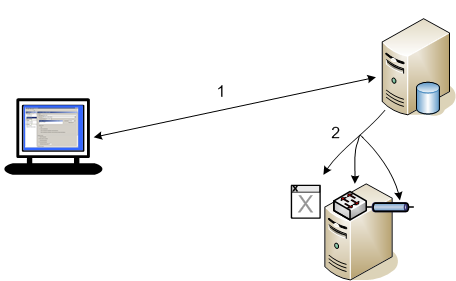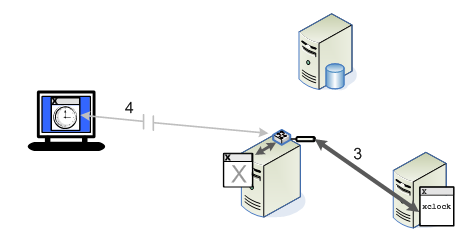X Manager for Domains Distributed Session
Reflection X sessions that use Remote session services can have several advantages over basic sessions, including session persistence and improved performance in high latency or low bandwidth networks.
All of the following Remote session services options create a distributed session. In a distributed session, the client connector and protocol router are created on a remote domain node, not on the workstation running X Manager for Domains. Each of these options also supports creating a headless X server on that domain node. The difference between the options is in how they control creation of the headless X server.
-
Session suspend/resume
A headless X server is created on the domain node only when you leave the session or close X Manager for Domains. This enables you to rejoin the session at a later time.
-
Session suspend/resume; High-latency network performance
Reflection X automatically measures the latency of the connection and creates a headless X server if the delay is significant enough to affect performance. The headless X server helps improve performance by reducing the amount of data that needs to pass over the network.
-
Session suspend/resume; High-latency network performance; Network fault tolerance
This option forces creation of a headless X server whenever the session is running. This can improve performance where high-latency is a concern and also ensures that the session remains running even if a workstation is disconnected due to a power or network failure.
Here is a sample sequence of events when Session suspend/resume; High-latency network performance; Network fault tolerance is enabled.
-
The user logs into the domain. (See the arrow labeled 1 in the following illustration.)
-
When the user starts a session, the domain controller sets up the session processes (a client connector, protocol router, and a headless X server) on a domain node. (See the arrow labeled 2 in the following illustration.) It also starts an X server display on the user's workstation (shown in the second illustration).

-
The X client establishes a connection with the client connector. All X protocol passes to the headless X server on the domain node. (See the arrow labeled 3 in the following illustration.)
-
The X protocol required to update the display is passed on to the X server display on the workstation. (See the arrow labeled 4 in the following illustration.)

note
In high latency networks, this configuration improves performance by short circuiting some of the data exchange over the network. When a headless X server is running, client/server exchanges that don't affect the display pass between the client and the headless X server, but aren't sent on to the X server display on the workstation. This reduces the number of round trip network messages, and this can improve the response time you see on your workstation.
Compression to Remote Workstations
If you are connecting over a low bandwidth network, protocol compression can improve performance. Reflection X is configured by default to compress protocol to remote X servers. When you configure a distributed session (as shown above) with this default setting, the protocol that passes between the domain node and the workstation (identified with the label 4 in the diagram above) is compressed.
More information